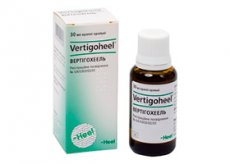Medical expert of the article
New publications
Preparations
Vertigoheel
Last reviewed: 04.07.2025

All iLive content is medically reviewed or fact checked to ensure as much factual accuracy as possible.
We have strict sourcing guidelines and only link to reputable media sites, academic research institutions and, whenever possible, medically peer reviewed studies. Note that the numbers in parentheses ([1], [2], etc.) are clickable links to these studies.
If you feel that any of our content is inaccurate, out-of-date, or otherwise questionable, please select it and press Ctrl + Enter.

Vertigoheel has a vasodilating, oligodynamic and psychotonic effect.
The drug demonstrates a stimulating effect on the central nervous system, affecting the brain and spinal cord; in addition, it promotes the binding of adrenaline with its subsequent release through the synaptic gap. The elements of the drug complement each other harmoniously, while at the same time quite gently, but significantly affecting the nervous system.
Indications Vertigoheel
It is used for the following disorders:
- having vascular or neurogenic etiology of dizziness;
- seasickness;
- conditions observed after concussions or TBI.
 [ 1 ]
[ 1 ]
Release form
The drug is released in drops - inside 30 ml bottles equipped with a dropper.
It is also produced in the form of lozenges - 50 pieces per package.
Pharmacodynamics
The therapeutic effect of a drug is determined by the properties of its constituent elements.
Anamirta cocculus is used for nausea associated with vestibular disorders, motion sickness, and cerebral sclerosis. In addition, the component is used in cases of mood disorders, depressive states, and nerve damage - for example, in case of lack of sleep and some types of dizziness.
Conium maculatum is used in cases of depression or cerebral sclerosis.
Ambergris grisea is used in cases of nervous or psycho-emotional exhaustion, depression, disorders of the autonomic nervous system, premature aging and cerebral sclerosis.
Petroleum rectificatum demonstrates a noticeable effect during the treatment of vestibular disorders, dizziness and inflammation in the gastrointestinal tract.
Dosing and administration
The medication in both forms is used for oral use.
The tablets must be taken (dissolved) 3 times a day, 1 piece at a time.
In case of nausea in the active phase or sudden dizziness, you should first take 1 tablet at 15-minute intervals, but for a maximum of 2 hours. Treatment continues for 2-3 weeks.
Treatment and prevention of dizziness that develops when traveling in transport requires taking 1 tablet at 15-minute intervals. They should be taken 60 minutes before the trip, and also, if necessary, for an hour during it. Then the drug is used daily, 1 tablet 3 times a day.
The drops are used in dissolved form - 10 drops per 0.1 l of plain water. The medicine should be taken daily, 3 times a day.
In case of acute nausea or sudden dizziness, you need to drink 10 drops of the medicine with 15-minute breaks, but a maximum of 120 minutes. This treatment can continue for 2-3 weeks.
To eliminate or prevent dizziness during a trip in any transport, it is necessary to use 10 drops of the medicine at 15-minute intervals. The procedures are carried out 1 hour before the trip or during it.
If the medication is not effective enough, you should consult your doctor.
 [ 3 ]
[ 3 ]
Use Vertigoheel during pregnancy
Vertigoheel is not prescribed in case of breastfeeding or pregnancy.
Contraindications
Contraindicated for use in case of severe personal intolerance to its components.
The tablets are not used in patients with glucose-galactose malabsorption, lactase deficiency and hypolactasia.
It should be used with caution in individuals with liver pathologies complicated by TBI, alcoholism and cerebral diseases.
Side effects Vertigoheel
During therapy with Vertigoheel, allergy symptoms may occur. In such cases, you should consult a doctor.
 [ 2 ]
[ 2 ]
Shelf life
Vertigoheel can be used within a 5-year period from the date of sale of the medicinal substance.
Application for children
Not used in pediatrics (under 18 years of age).
Analogues
The analogs of the drug are Trental, Tonginal with Tenoten and Betahistine.
Reviews
Vertigoheel, based on reviews on many forums, is considered not a very effective medication. When using it, people with VSD only occasionally noted relief, and in most cases, a feeling similar to a pre-fainting condition continued to persist in patients.
Medical professionals believe that homeopathic substances may not always have a significant therapeutic effect, which is why they prefer to prescribe their patients classical medications that have a lasting effect.
Attention!
To simplify the perception of information, this instruction for use of the drug "Vertigoheel" translated and presented in a special form on the basis of the official instructions for medical use of the drug. Before use read the annotation that came directly to medicines.
Description provided for informational purposes and is not a guide to self-healing. The need for this drug, the purpose of the treatment regimen, methods and dose of the drug is determined solely by the attending physician. Self-medication is dangerous for your health.

